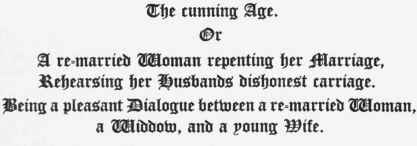A PEPYSIAN GARLAND - online book
Black-letter Broadside Ballads Of The years 1595-1639
| Share page | Visit Us On FB |
|
42
The cunning age
Pepys, i, 412, B.L., four woodcuts, four columns.
As John Trundle printed this ballad, it cannot have appeared later than 1626. Perhaps, as is pointed out in the introduction to the ballad immediately preceding, it as well as No. 41 was printed a year or two earlier. It was registered at Stationers' Hall by John Wright and his five partners on June 1, 1629, under the tide of "The Conning cosening age" (Arber's Transcript, iv, 213).
The song was written as a direct answer to Martin Parker's "Wiving Age" (No. 41). The author, John Cart, represents an irate widow as bitterly denying the truth of Parker's attack on her sisterhood, as scoffing at the thought of remarrying, and as anxious to get her clutches on Parker. J. C, probably Cart, was the author of "A Lesson for all True Christians" (Roxburghe Ballads, vn, 814); a later ballad entitled "A Warning for Swearers" {ibid, vm, 76), though signed J. C, can hardly have been his work.
The tune is equivalent to Whoop, do me no harm, good man (cf. No. 41).
 To the Tune of The Wiuing Age. Widdow. I GOod morrow, kind Gossip, why whither so fast ? I pray stay a while, I know ther's no haste, And let's chat a while of some things that are past; I heare say y' are married since I saw you last; O this is a hasty Age, O this is a hasty Age. |
||
|
239 |
||